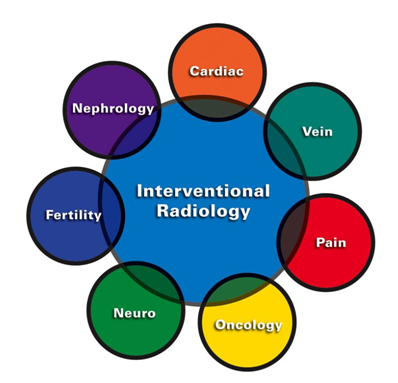Interventional radiology (IR), or Vascular interventional Radiology (VIR) or Interventional Neuroradiology (INR), is a new specialty that has been responsible for major recent medical advancement. It is at the forefront of medical technology and innovation. Although IR is less well known by GPs, IR is typically referred to as the specialist’s ‘specialist’. It is responsible for image-guided minimally invasive procedures and therapies you may have thought more usually carried out by surgeons. IR is a minimally invasive alternative to open surgery that uses radiological image guidance (X-rays, ultrasound, CT and MRI) to aid treatment. In many circumstances, surgery can be avoided and the risks to the patient can be lowered with faster recovery times. IR can also be used as an adjuvant to surgery and combined procedures with surgeons can optimise patient care.

IR developed in diagnostic angiography in the 1960s, after the Seldinger technique was described by Dr Sven-IvarSeldinger in 1953. The technique described used a hollow needle and guide wire to access a vessel.
An American radiologist, Dr Charles Dotter, altered the course of cardiovascular interventional radiology in 1964 and is considered the father of IR. He modified the Seldinger technique for therapeutic purposes. On 16 January 1964, IR was born when Dotter percutaneously dilated a tight stenosis of a femoral artery, using a plastic tube (catheter), in an 82-year-old lady with painful leg ischaemia and gangrene who refused amputation. Following this, despite scepticism from his surgical colleagues, the leg pain ceased, she started walking and her leg improved.
Dr Charles Dotter was nominated for the Nobel Prize in Medicine in 1978. The term ‘interventional radiology’, however, was not conceived until March 1967 when an American radiologist, Alexander Margulis, described it in an edition of the American Journal of Roentgenology.

Charles Theodore Dotter
“Father of Interventional Radiology.”
IRs have expertise in guiding small needles, catheters and other medical equipment into the body through tiny (5–10 mm) incisions in the skin to treat disease. The treatments performed are truly minimally invasive. However, the basic skills of an IR are still image interpretation and, therefore, core diagnostic radiology is at the heart of interventional radiology training. This combined skill has meant that there is hardly any area of hospital medicine where IR has not had an impact on patient management.
You may be surprised to know the extent of therapies now performed predominantly by IRs. Traditionally surgeons performed a lot of these procedures, although a significant amount of treatments are new and innovative. Virtually all body parts and systems can be treated using IR techniques.
However, broad categories of treatments available include:
- Draining of fluid collections (abscesses, dilated kidneys, pleural effusions)
- Opening up of blocked tubes (arteries, veins, bile ducts, ureters, fallopian tubes etc)
- Stopping bleeding from any cause (gastrointestinal bleeding, obstetric and gynaecological bleeding, traumatic bleeding, bleeding after surgery, brain aneurysms, vascular malformations) by occluding the vessels with embolisation
- Destroying tumours in the liver, lung, kidney by delivering local chemotherapy, embolisation or ablation techniques (such as cryotherapy and radiofrequency ablation)
- Minimally invasive treatments of thoracic and abdominal aneurysms
- Preoperative embolisation to improve the safety of surgery.
Patient safety IRs pioneered the safe and high-quality procedures and standards for performing minimally invasive therapies, with a concentration on patient safety. IRs are specialists of radiology, who have completed further education and training in diagnostic radiology and interventional radiology including radiation safety, radiation physics, the biological effects of radiation, injury prevention and clinical practice.

It has a number of benefits for patients
- Rapid relief from symptoms.
- The imaging techniques allow accurate diagnosis and treatment using cutting-edge equipment. Diagnosis is reconfirmed during procedure.
- Minimally invasive procedures are performed through a small hole in the skin, minimising the patient’s discomfort and recovery time. There won’t be any scar.
- Most procedures can be performed on an outpatient basis or require only a short hospital stay. As interventional procedures tend to require only local anaesthesia, hospital stays are very short, with patients frequently going home the day the procedure is performed.
- Patients who undergo IR procedures experience less pain during and after the procedure than patients undergoing surgical procedures. Post-procedural care is provided, along with follow-up imaging to confirm if the treatment has been successful.
- Minimal damage to surrounding vital anatomical structures with no significant structural weakness.
- No or negligible blood loss. No requirement of blood transfusion.
- Return to work and other normal activities usually next day after procedure.A significant number of these procedures are performed as day cases.
- Low risk compared to surgery. The techniques can be used in very sick patients who are unfit for surgery.
- Overall procedure is less expensive than surgery or other alternatives.
The answer is yes. IR is a progressive specialty and is developing at a fantastic speed. Most IRs offer direct referrals from your GP with no need to be seen by another specialist (traditionally a surgeon). IRs often run outpatient clinics and have access to day-case beds if you need a simple procedure. IRs typically work as part of a multidisciplinary team within hospitals, so are able to refer you to another team member if it is appropriate. IRs are happy to discuss patient management with your GP if they need advice. Milestones of IR You may be surprised to learn of the advancements in medicine that have been primarily down to IR innovation.
Milestones Pioneered by Interventional Radiologists.
You may not even have known that IR had been involved. Here are milestones of IR.
1964 Angioplasty
1966 Embolization therapy to treat tumors and spinal cord vascular malformations by blocking the blood flow
1967 The Judkins technique of coronary angiography, the technique still most widely used around the world today
1967 Closure of the patent ductusarteriosis, a heart defect in newborns of a vascular opening between the pulmonary artery and the aorta
1967 Selective vasoconstriction infusions for hemorrhage, now commonly used for bleeding ulcers, GI bleeding and arterial bleeding
1969 The catheter-delivered stenting technique and prototype stent
1960-74 Tools for interventions such as heparinized guidewires, contrast injector, disposable catheter needles and see-through film changer
1970’s Percutaneous removal of common bile duct stones
1970’s Occlusive coils
1972 Selective arterial embolization for GI bleeding, which was adapted to treat massive bleeding in other arteries in the body and to block blood supply to tumors
1973 Embolization for pelvic trauma
1974 Selective arterial thrombolysis for arterial occlusions, now used to treat blood clots, stroke, DVT, etc.
1974 Transhepatic embolization for variceal bleeding
1977-78 Embolization technique for pulmonary arteriovenous malformations and varicoceles
1977-83 Bland- and chemo-embolization for treatment of hepatocellular cancer and disseminated liver metastases
1980 Cryoablation to freeze liver tumors
1980 Development of special tools and devices for biliary manipulation
1980’s Biliary stents to allow bile to flow from the liver saving patients from biliary bypass surgery
1981 Embolization technique for spleen trauma
1982 TIPS (transjugular intrahepatic portosystemic shunt) to improve blood flow in damaged livers from conditions such as cirrhosis and hepatitis C
1982 Dilators for interventional urology, percutaneous removal of kidney stones
1983 The balloon-expandable stent (peripheral) used today
1985 Self-expandable stents
1990 Percutaneous extraction of gallbladder stones
1990 Radiofrequency ablation (RFA) technique for liver tumors
1990’s Treatment of bone and kidney tumors by embolization
1990’s RFA for soft tissue tumors, i.e., bone, breast, kidney, lung and liver cancer
1991 Abdominal aortic stent grafts
1994 The balloon-expandable coronary stent used today
1997 Intra-arterial delivery of tumor-killing viruses and gene therapy vectors to the liver
1999 Percutaneous delivery of pancreatic islet cells to the liver for transplantation to treat diabetes
1999 Developed the endovenous laser ablation procedure to treat varicose veins and venous disease
GENERAL ENQURIES
- +91 9930119960 / +91 9222266335
veinclinics@gmail.com
info@veinclinic.com
SMC Medical Center,
Near Starbucks Coffee Shop,
Link Corner Mall, Off Linking Road,
Behind KFC, Bandra (West),
Mumbai: 400050.
OFFICE HOURS
| Monday – Firday | 8:00 – 5:00 |
| Saturday | 9:00 – 5:00 |
| Sunday | 11:00 – 4:00 |
